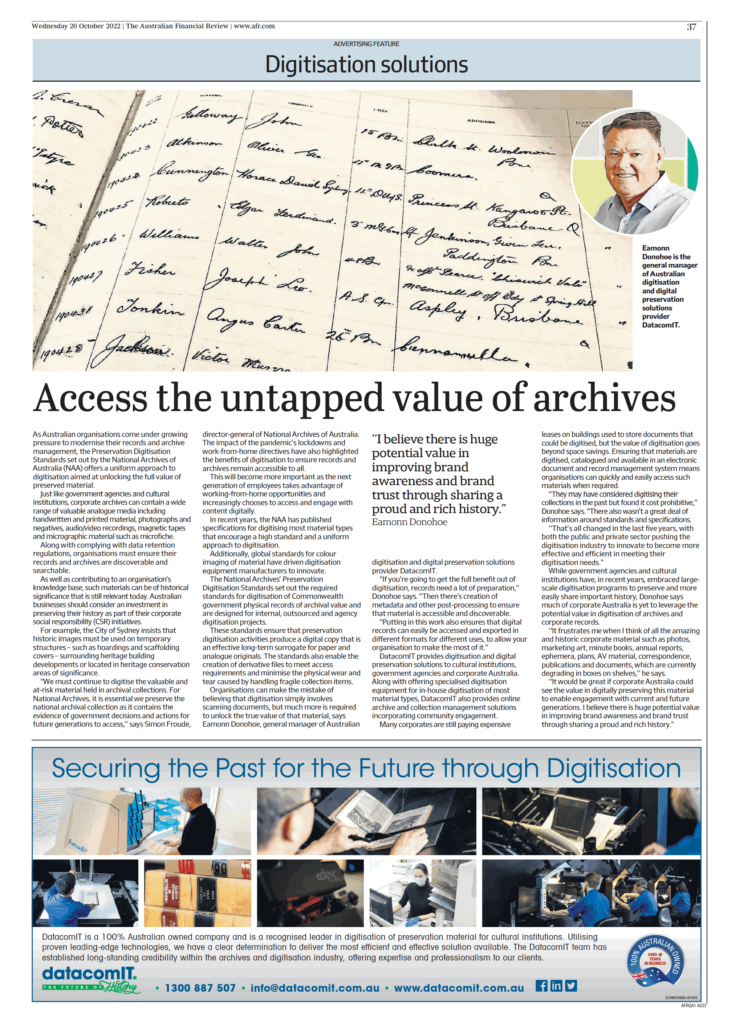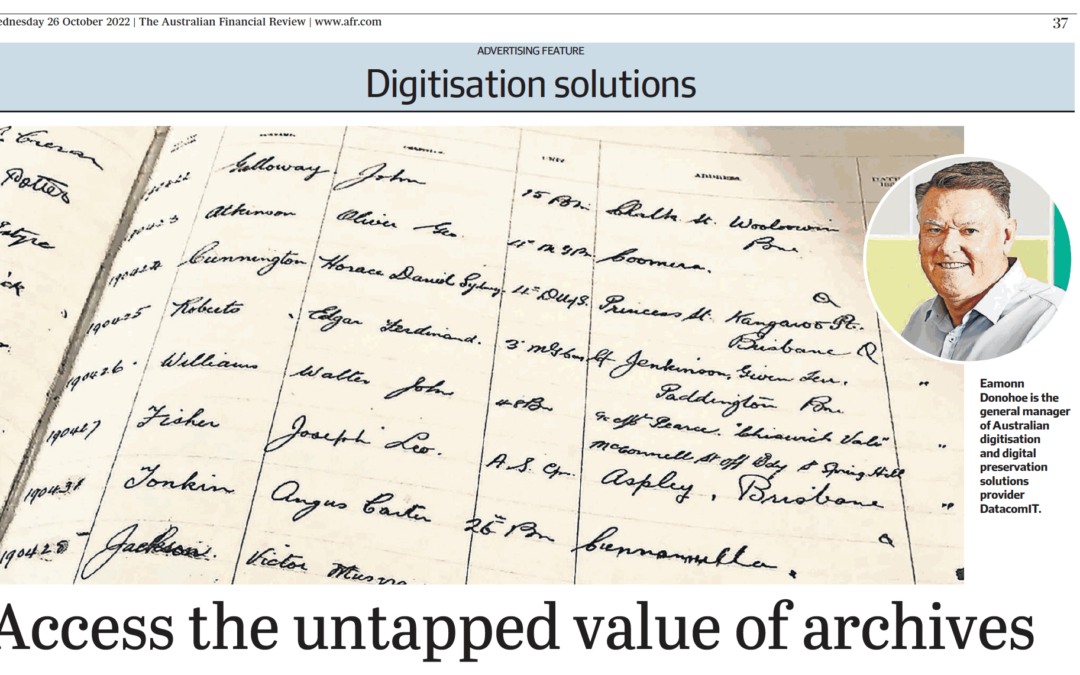We’re thrilled to be featured in the Australian Financial Review – Wednesday 26 October 2022 edition.
Our General Manager, Eamonn Donohoe, expresses the importance of digitising and digitally preserving historical material, as much of corporate Australia is yet to leverage the potential value in digitisation of archives and corporate records.
Read full article below:
DIGITISATION SOLUTIONS – ACCESS THE UPTAPPED VALUE OF ARCHIVES
As Australian organisations come under growing pressure to modernise their records and archive management, the Preservation Digitisation Standards set out by the National Archives of Australia (NAA) offers a uniform approach to digitisation aimed at unlocking the full value of preserved material.
Just like government agencies and cultural institutions, corporate archives can contain a wide range of valuable analogue media including handwritten and printed material, photographs and negatives, audio/video recordings, magnetic tapes and micrographic material such as microfiche.
Along with complying with data retention regulations, organisations must ensure their records and archives are discoverable and searchable.
As well as contributing to an organisation’s knowledge base, such materials can be of historical significance that is still relevant today. Australian businesses should consider an investment in preserving their history as part of their corporate social responsibility (CSR) initiatives.
For example, the City of Sydney insists that historic images must be used on temporary structures – such as hoardings and scaffolding covers – surrounding heritage building developments or located in heritage conservation areas of significance.
“We must continue to digitise the valuable and at-risk material held in archival collections. For National Archives, it is essential we preserve the national archival collection as it contains the evidence of government decisions and actions for future generations to access”, says Simon Froude, director-general of National Archives of Australia. The impact of the pandemic’s lockdowns and work-from-home directives have also highlighted the benefits of digitisation to ensure records and archives remain accessible to all.
This will become more important as the next generation of employees takes advantage of working-from-home opportunities and increasingly chooses to access and engage with content digitally.
In recent years, the NAA has published specifications for digitising most material types that encourage a high standard and a uniform approach to digitisation.
Additionally, global standards for colour imaging of material have driven digitisation equipment manufacturers to innovate.
The National Archives Preservation Digitisation Standards set out the required standards for digitisation of Commonwealth government physical records of archival value and are designed for internal, outsourced and agency digitisation projects.
These standards ensure that preservation digitisation activities produce a digital copy that is an effective long-term surrogate for paper and analogue originals. The standards also enable the creation of derivative files to meet access requirements and minimise the physical wear and tear caused by handling fragile collection items.
Organisations can make the mistake of believing that digitisation simply involves scanning documents, but much more is required to unlock the true value of that material, says Eamonn Donohoe, general manager of Australian digitisation and digital preservation solutions provider DatacomIT.
“If you’re going to get the full benefit out of digitisation, records need a lot of preparation,” Donohoe says. “Then there’s creation of metadata and other post-processing to ensure that material is accessible and discoverable.”
Putting in this work also ensures that digital records can easily be accessed and exported in different formats for different uses, to allow your organisation to make the most of it.”
DatacomIT provides digitisation and digital preservation solutions to cultural institutions, government agencies and corporate Australia. Along with offering specialised digitisation equipment for in-house digitisation of most material types, DatacomIT also provides online archive and collection management solutions incorporating community engagement.
Many corporates are still paying expensive leases on buildings used to store documents that could be digitised, but the value of digitisation goes beyond space savings. Ensuring that materials are digitised, catalogued and available in an electronic document an record management system means organisations can quickly and easily access such materials when required.
“They may have considered digitising their collections in the past but found it cost prohibitive,” Donohoe says. “There also wasn’t a great deal of information around standards and specifications.
“That’s all changed in the last five years, with both the public and private sector pushing the digitisation industry to innovate to become more effective and efficient in meeting their digitisation needs.” While government agencies and cultural institutions have, in recent years, embraced large-scale digitisation programs to preserve and more easily share important history, Donohoe says much of corporate Australia is yet to leverage the potential value in digitisation of archives and corporate records.
It frustrates me when I think of all the amazing and historic corporate material such as photos, marketing art, minute books, annual reports, ephemera, plans, AV material, correspondence, publications and documents, which are currently degrading in boxes on shelves,” he says. “It would be great if corporate Australia could see the value in digitally preserving this material to enable engagement with current and future generations. I believe there is huge potential value in improving brand awareness and brand trust through sharing a proud and rich history.”


